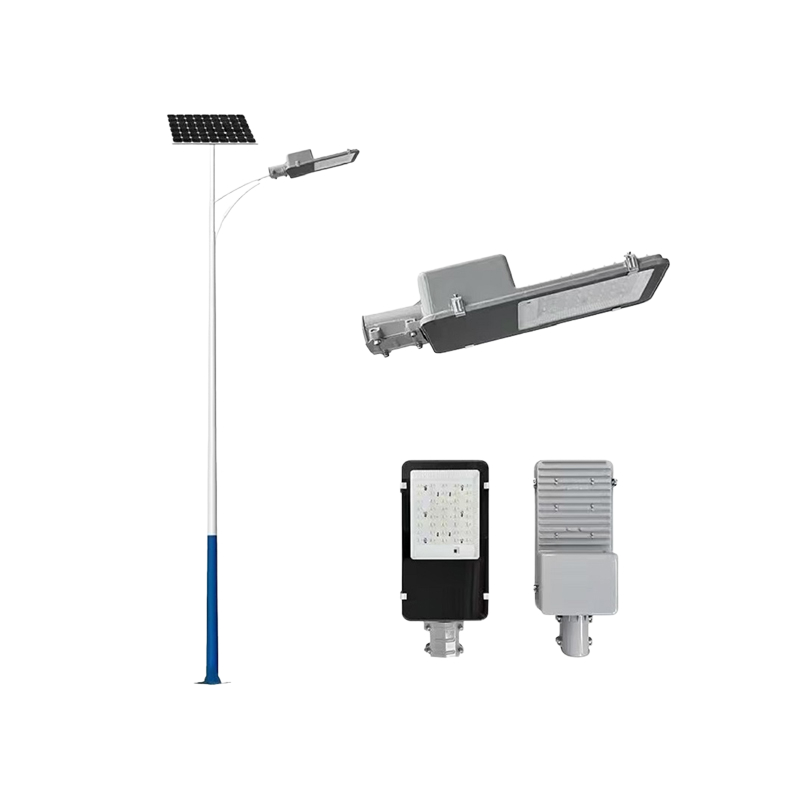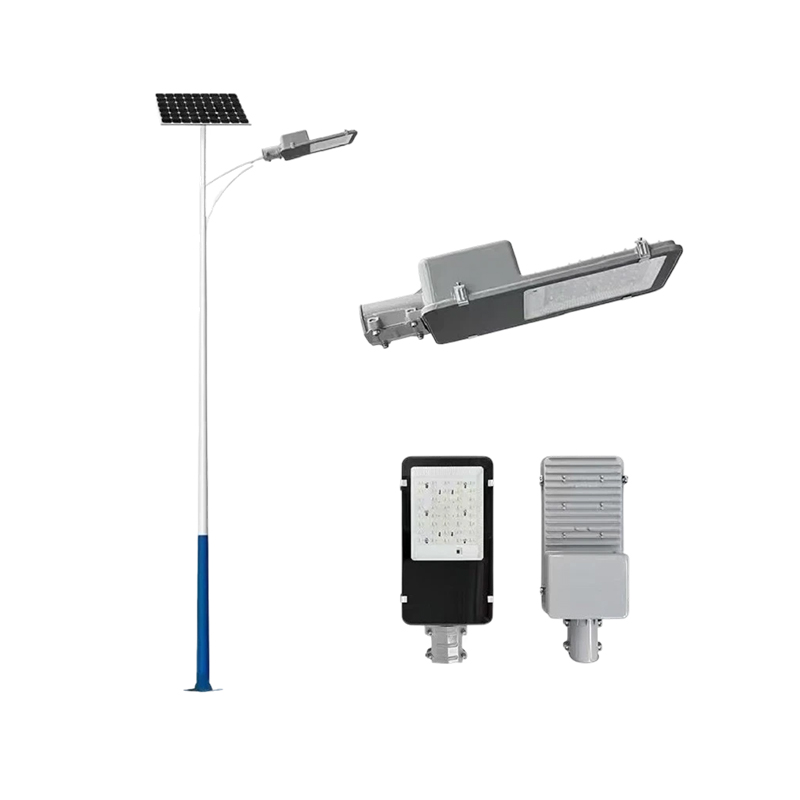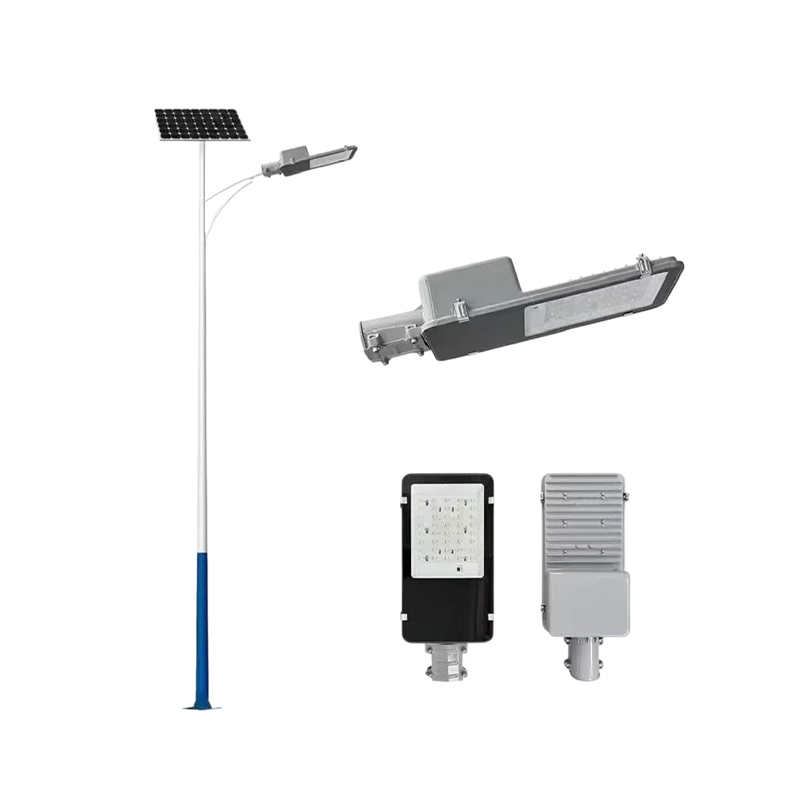How do solar street lights improve their overall structural strength through Q235 steel and one-time formed cones?
Release Time : 2025-07-14
As an important part of modern urban and rural lighting systems, the structural strength of solar street lights is directly related to the safety and service life of the equipment. Solar street lights designed with Q235 steel and one-time formed cones have demonstrated excellent performance in improving overall structural strength, ensuring stable operation even in harsh environments.
First of all, Q235 steel is an ideal choice for solar street lights pole material due to its excellent mechanical properties. This steel has good toughness and plasticity, and can remain unchanged when subjected to large external forces, effectively preventing damage caused by wind pressure, snow load or accidental collision. Q235 steel not only has high tensile strength, but also has excellent welding performance, allowing the various parts of the street light pole to be firmly connected to form a solid whole. This provides a solid support foundation for the street lights, ensuring their stability both in daily use and in the face of extreme weather conditions.
The application of one-time formed cone technology further enhances the overall structural strength of solar street lights. Compared with the traditional multi-section splicing method, the one-time formed cone tube avoids the potential weak points caused by too many welds, thereby improving the continuity and consistency of the entire pole. The conical design gives the street light pole a unique mechanical advantage: the upper part is thinner and the lower part is thicker. This shape is not only beautiful, but also can better disperse the gravity load brought by the solar panels and lighting components installed on the top. Due to the low center of gravity and uniform force distribution, the one-time formed cone tube can effectively resist lateral wind and other external impacts, ensuring the long-term safe operation of the street light.
In addition, after the Q235 steel is hot-dip galvanized, a corrosion-resistant zinc layer is formed on the surface, which greatly extends the service life of the street light pole. The hot-dip galvanizing process not only improves the hardness of the steel itself, but also gives it stronger antioxidant ability. Even in humid or rainy environments, the street light pole is not easy to rust or corrode, and always maintains a good appearance and structural integrity. This long-term protective measure reduces the need for later maintenance and reduces operating costs, while also ensuring that the street light can work normally under various complex climatic conditions.
It is worth noting that the design of the disposable cone tube takes into account the convenience of transportation and installation. Compared with traditional street light poles that require a lot of assembly work on site, the disposable cone tube can complete most of the processing procedures in the factory in advance, and only needs simple installation on site to be put into use. This not only saves construction time, but also reduces the quality problems that may be caused by on-site operations. In addition, the standardized production process helps to ensure the consistency of product quality. Each cone tube strictly follows the same manufacturing standards to ensure that the solar street lights finally delivered for use meet the expected structural strength requirements.
From an environmental protection perspective, the application of Q235 steel and disposable cone tubes also reflects the concept of sustainable development. As a recyclable and reusable metal material, steel can still be remade into new products through smelting and other methods after the end of the product life cycle, reducing resource waste and environmental pollution. At the same time, the optimized production process reduces energy consumption and carbon emissions. This green manufacturing model meets the requirements of modern society for environmental protection and also establishes a responsible corporate image for the brand.
In actual application scenarios, solar street lights show wide applicability with its strong structural strength. Whether it is a busy city street, a quiet country lane or a road in a remote mountainous area, it can provide reliable lighting services. Especially for those areas at high altitudes, frequent strong winds or heavy snowfall, the stable structure of solar street lights is particularly important. It can not only withstand the challenges brought by harsh natural conditions, but also automatically adjust the brightness without supervision, turn on in time according to the degree of darkness and continue to work for several hours to ensure the safe passage of pedestrians and vehicles.
Finally, it is worth mentioning that with the advancement of technology and changes in market demand, the design of solar street lights is also constantly innovating and improving. In addition to continuing to strengthen the structural strength, manufacturers are also actively exploring more intelligent functions, such as remote monitoring, fault warning, etc., in order to provide users with more convenient and efficient management solutions. At the same time, launching customized services for different customer needs has also become one of the development trends of the industry. By flexibly adjusting parameters such as lamp pole height, lamp power and battery capacity, the needs of diverse application scenarios can be met, and the "people-oriented" design concept can be truly realized.
In summary, solar street lights significantly improve the overall structural strength by using Q235 steel and one-time formed cone tubes, so that they can still work stably and reliably in various complex environments. This advanced design not only extends the service life of street lights, but also reduces maintenance costs and improves user experience. In the future, with the continuous emergence of new materials and new technologies, it is believed that solar street lights will play an important role in more fields and contribute to the construction of smart cities.
First of all, Q235 steel is an ideal choice for solar street lights pole material due to its excellent mechanical properties. This steel has good toughness and plasticity, and can remain unchanged when subjected to large external forces, effectively preventing damage caused by wind pressure, snow load or accidental collision. Q235 steel not only has high tensile strength, but also has excellent welding performance, allowing the various parts of the street light pole to be firmly connected to form a solid whole. This provides a solid support foundation for the street lights, ensuring their stability both in daily use and in the face of extreme weather conditions.
The application of one-time formed cone technology further enhances the overall structural strength of solar street lights. Compared with the traditional multi-section splicing method, the one-time formed cone tube avoids the potential weak points caused by too many welds, thereby improving the continuity and consistency of the entire pole. The conical design gives the street light pole a unique mechanical advantage: the upper part is thinner and the lower part is thicker. This shape is not only beautiful, but also can better disperse the gravity load brought by the solar panels and lighting components installed on the top. Due to the low center of gravity and uniform force distribution, the one-time formed cone tube can effectively resist lateral wind and other external impacts, ensuring the long-term safe operation of the street light.
In addition, after the Q235 steel is hot-dip galvanized, a corrosion-resistant zinc layer is formed on the surface, which greatly extends the service life of the street light pole. The hot-dip galvanizing process not only improves the hardness of the steel itself, but also gives it stronger antioxidant ability. Even in humid or rainy environments, the street light pole is not easy to rust or corrode, and always maintains a good appearance and structural integrity. This long-term protective measure reduces the need for later maintenance and reduces operating costs, while also ensuring that the street light can work normally under various complex climatic conditions.
It is worth noting that the design of the disposable cone tube takes into account the convenience of transportation and installation. Compared with traditional street light poles that require a lot of assembly work on site, the disposable cone tube can complete most of the processing procedures in the factory in advance, and only needs simple installation on site to be put into use. This not only saves construction time, but also reduces the quality problems that may be caused by on-site operations. In addition, the standardized production process helps to ensure the consistency of product quality. Each cone tube strictly follows the same manufacturing standards to ensure that the solar street lights finally delivered for use meet the expected structural strength requirements.
From an environmental protection perspective, the application of Q235 steel and disposable cone tubes also reflects the concept of sustainable development. As a recyclable and reusable metal material, steel can still be remade into new products through smelting and other methods after the end of the product life cycle, reducing resource waste and environmental pollution. At the same time, the optimized production process reduces energy consumption and carbon emissions. This green manufacturing model meets the requirements of modern society for environmental protection and also establishes a responsible corporate image for the brand.
In actual application scenarios, solar street lights show wide applicability with its strong structural strength. Whether it is a busy city street, a quiet country lane or a road in a remote mountainous area, it can provide reliable lighting services. Especially for those areas at high altitudes, frequent strong winds or heavy snowfall, the stable structure of solar street lights is particularly important. It can not only withstand the challenges brought by harsh natural conditions, but also automatically adjust the brightness without supervision, turn on in time according to the degree of darkness and continue to work for several hours to ensure the safe passage of pedestrians and vehicles.
Finally, it is worth mentioning that with the advancement of technology and changes in market demand, the design of solar street lights is also constantly innovating and improving. In addition to continuing to strengthen the structural strength, manufacturers are also actively exploring more intelligent functions, such as remote monitoring, fault warning, etc., in order to provide users with more convenient and efficient management solutions. At the same time, launching customized services for different customer needs has also become one of the development trends of the industry. By flexibly adjusting parameters such as lamp pole height, lamp power and battery capacity, the needs of diverse application scenarios can be met, and the "people-oriented" design concept can be truly realized.
In summary, solar street lights significantly improve the overall structural strength by using Q235 steel and one-time formed cone tubes, so that they can still work stably and reliably in various complex environments. This advanced design not only extends the service life of street lights, but also reduces maintenance costs and improves user experience. In the future, with the continuous emergence of new materials and new technologies, it is believed that solar street lights will play an important role in more fields and contribute to the construction of smart cities.







